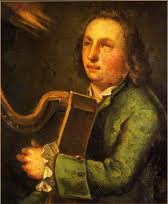Annotation:Mrs. Crofton
Back to Mrs. Crofton
MRS. CROFTON (Bain Tighearna Crofton). AKA - "Mrs. Crofton." Irish, Planxty (cut time). E Minor. Standard tuning (fiddle). One part (O'Sullivan/Bunting): AB (Complete Collection). Both words and air to this ode of praise to Elizabeth Crofton were composed by the great blind Irish harper Turlough O'Carolan. O'Sullivan (1983) notes the Croftons were once a Catholic family and originally migrated to Ireland in Elizabethan times. Elizabeth was the wife of James Crofton (third son of Edward Crofton) of Longford House, situated on the northerly slope of the Ox Mountains near Ballysodare, County Sligo. A family memoir published in 1911 has it that Elizabeth (the daughter of Captian Edward Robinson of Sligo and a Protestant) and James fell in love around the year 1729, but that "the father of each was bitterly opposed to the match. James tried in vain to win his father's consent. At last, acting on the principle that 'all is fair in love and war,' he decided to become a Protestant. His father threatened to cut him off without a shilling if he did so, and he retorted that two could play at that game, and he would turn informer and claim forfeiture of the family estates unless his father would consent to the marriage, but the unhappy Edward declined to make any terms with his son." James followed through on his threat, converted to Protestantism, denounced his father and older brothers, and, under the laws of the time was awarded the family estates for renouncing Papism. He soon married Elizabeth, while his two elder brothers fled the country for France, one becoming an Archbishop and the other Governor of La Hogue. See also "James Crofton".

The air (along with “Green Woods of Truigha (The)”) was played by the blind harper Arthur O’Neill (1734-1818) at the first Granard Harp Competition in 1781, a performance which earned him the second prize of eight guineas. In his memoirs O’Neill (1734-1818) writes of his travels following the second Granard harp festivel in 1782, where he stopped at the houses of various patrons. He records: “From Mr. Irwin’s I came to Mrs. Crofton of Longford, the name of her seat in the County Sligo. She was the mother of Sir Malby Crofton. She was the lady for whom Carolan composed the fine tune of ‘Mrs. Crofton’. I remained there only a few days…” If the same woman, Mrs. Crofton would have been quite elderly at the time.
The tune was recorded by the Belfast Northern Star of July 15, 1792, as having been played in competition by one of ten Irish harp masters at the last great convocation of ancient Irish harpers, the Belfast Harp Festival, held that week.
Source for notated version: The Irish collector Edward Bunting noted the tune from Charles Fanning [1] in 1792. O'Sullivan (1958) had the tune from Bunting's manuscript collection.
Printed sources: Bunting (Ancient Music of Ireland), 1840; No. 22, p. 19. Complete Collection of Carolan's Irish Tunes, 1984; No. 24, p. 38. O'Neill (Krassen), 1976; p. 245. O'Neill (Music of Ireland: 1850 Melodies), 1903; No. 697, p. 129. O'Sullivan/Bunting, 1983; No. 22, pp. 36-37. O'Sullivan (Carolan: The Life, Times and Music of an Irish Harper), 1958; No. 24.
Recorded sources:
